The NVIDIA GeForce RTX 2080 Super Review: Memories of the Future
by Ryan Smith on July 23, 2019 9:00 AM EST- Posted in
- GPUs
- GeForce
- NVIDIA
- Turing
- GeForce RTX
Power, Temperatures, & Noise
Last, but not least of course, is our look at power, temperatures, and noise levels. While a high performing card is good in its own right, an excellent card can deliver great performance while also keeping power consumption and the resulting noise levels in check.
| GeForce Video Card Voltages | |||||
| RTX 2080S Boost | RTX 2080S Idle | RTX 2080 Boost | RTX 2070S Boost | ||
| 1.05v | 0.65v | 1.05v | 1.043v | ||
Overall, the voltages being used for the RTX 2080 Super are not any different than NVIDIA’s other TU104 cards – or any of their other Turing cards, for that matter. At its highest clockspeeds the card runs at 1.05v, quickly stepping down to below 1v at lower clockspeeds. The 0.65v idle voltage is among the lowest we’ve ever recorded for an NVIDIA card, however.
| GeForce Video Card Average Clockspeeds | |||||
| Game | RTX 2080S | RTX 2080 Ti | RTX 2080 | RTX 2070S | |
| Max Boost Clock | 1965MHz | 1950MHz | 1900MHz | 1950MHz | |
| Boost Clock | 1815MHz | 1545MHz | 1710MHz | 1770MHz | |
| Tomb Raider | 1937MHz | 1725MHz | 1785MHz | 1875MHz | |
| F1 2019 | 1920MHz | 1725MHz | 1785MHz | 1875MHz | |
| Assassin's Creed | 1920MHz | 1800MHz | 1815MHz | 1890MHz | |
| Metro Exodus | 1937MHz | 1755MHz | 1785MHz | 1875MHz | |
| Strange Brigade | 1920MHz | 1695MHz | 1770MHz | 1875MHz | |
| Total War: TK | 1937MHz | 1740MHz | 1785MHz | 1875MHz | |
| The Division 2 | 1937MHz | 1635MHz | 1740MHz | 1845MHz | |
| Grand Theft Auto V | 1937MHz | 1815MHz | 1815MHz | 1890MHz | |
| Forza Horizon 4 | 1937MHz | 1815MHz | 1800MHz | 1890MHz | |
Looking at clockspeeds, we can piece together a couple of interesting pieces of information. On the clockspeed side, NVIDIA hasn’t actually changed the card’s maximum clockspeed all that much. Our RTX topped out at 1900MHz, and the RTX 2080 Super is only a bit higher at 1965MHz. That they’re doing it without more voltage is a bit more interesting – it looks like chip quality may have improved a bit over the past year – but not too surprising.
What is more surprising however are the average clockspeeds we recorded for the RTX 2080 Super. In short, the card spends a lot of time at or near its top turbo bins. With temperature compensation active, our RTX 2080 Super tops out at 1937MHz; a clockspeed that it holds at for over half of our games even at 4K. Quite frankly the RTX 2080 Super is almost a boring card in this respect (in a good way); there’s just not much in the way of power throttling going on here. If anything, the hard part is getting the card above 90-95% power usage.
This, ultimately, is why the RTX 2080 Super is as fast as it is versus the vanilla RTX 2080. The extra SMs help, but it’s the extra 100-150MHz on the GPU clockspeed that’s really driving the card.
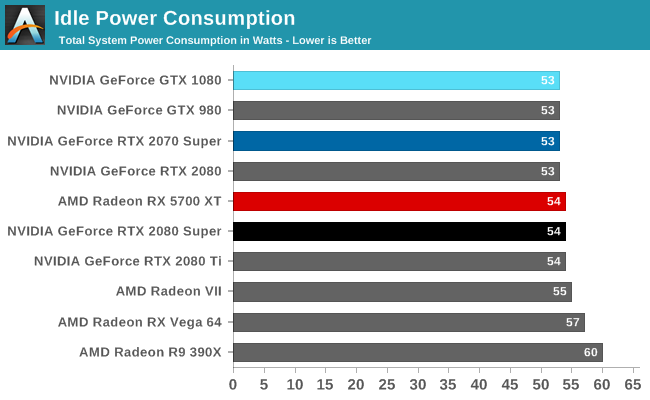
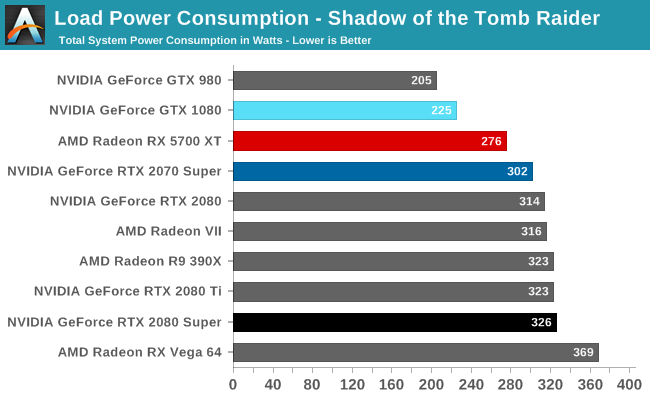
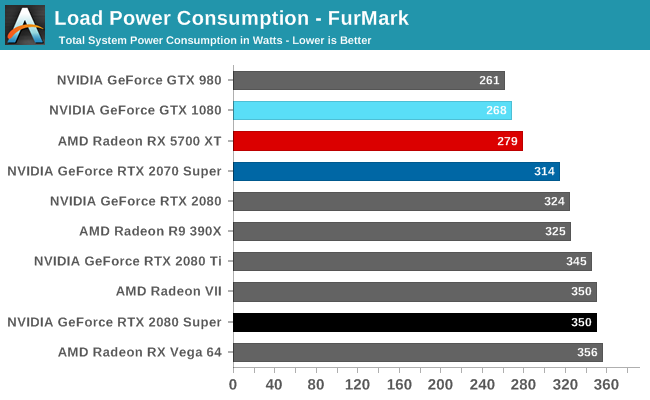
Getting to power consumption itself then, idle is effectively unchanged, exactly as we’d expect it. Load power, on the other hand, is paying the price for those 1900MHz+ clockspeeds. Under both FurMark and Tomb Raider, our RTX 2080 Super-equipped system is drawing almost the same amount of power as the RTX 2080 Ti system with a difference of just a few watts. That performance doesn’t come for free. NVIDIA’s overall power efficiency is still quite good here (the Radeon VII won’t be touching it, for example), but it’s clearly regressed a bit versus the RTX 2080 Ti and vanilla RTX 2080.
It is worth noting, however, that often the card was clockspeed-limited rather than power limited. So while Tomb Raider was specifically picked to be a punishing game – a task it delivered on here – I fully expect that the RTX 2080 Super is drawing a bit less than the RTX 2080 Ti in around half of our other games.
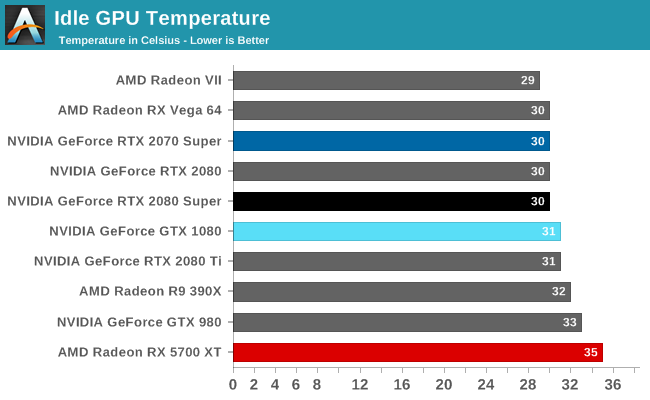
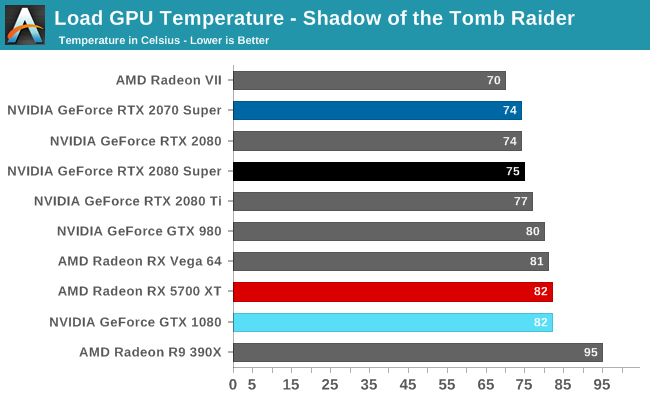

With higher power consumption and the same cooler comes higher temperatures. Even FurMark’s 77C is still several degrees below the card’s 84C thermal throttle point, but it is a very straightforward consequence of the increased power consumption.
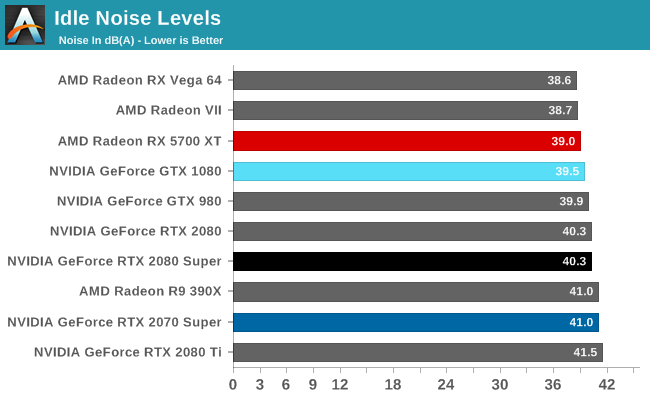
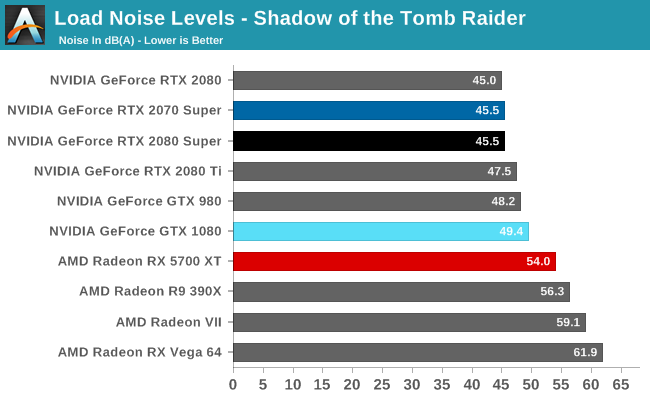
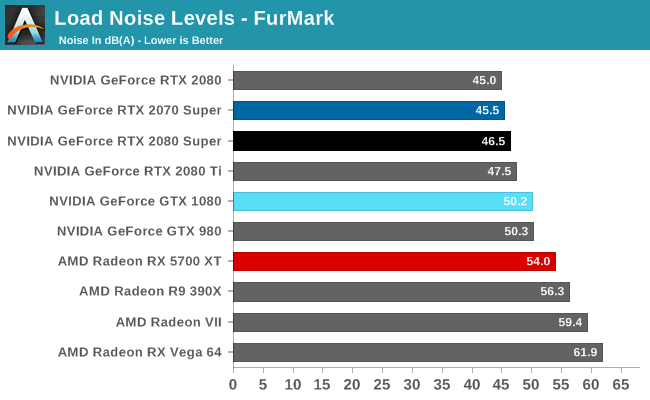
Last, but not least, we have noise. Again this is the same cooler as the RTX 2080 & RTX 2080 Ti, so the card has to work a bit harder to keep itself cool versus the original RTX 2080. The net result is that the RTX 2080 Super splits the difference between the original RTX 2080 and the RTX 2080 Ti, peaking at 46.5 dB(A). This is unlikely to be a very noticeable change as compared to the RTX 2080, but it’s louder none the less. I’m actually a bit surprised it didn’t pull even with the RTX 2080 Ti, but then our RTX 2080 Ti seems to run just a bit loud period – even at idle it’s a bit louder.










111 Comments
View All Comments
Zoolook - Thursday, July 25, 2019 - link
Essentially the GPU-division tided them over when the CPU-division didn't deliver, the new CPU cores where prioritized over developing the new GPU architecture for several years so it's no wonder they are behind on the GPU-side. Hopefully they will catch up for real in the next couple of years with the increased revenue flow put to good use.rocky12345 - Tuesday, July 23, 2019 - link
LOL to funny I guess when a mid range card like the 5700XT was able to almost match the performance of AMD's top card that cost a lot more than the 5700XT AMD has a real problem there for sure. The only coars eof action for AMD was to remove the Radeon 7 form the picture as it served no more purpose other than triggering reviewers after the 5700 cards came out.Now if I was Nvidia I would be some what worried as to what AMD has on the books and what the next move is going to be. If the mid range cards like the 5700's can topple AMD's top card and hang in there and beat Nvidia's mid top cards what will the Navi 20 chip be able to do. You have to know AMD is planning on doing to Nvidia what they have been doing to Intel right.
It has been proven and told by AMD themselves that they played Nvidia by showing higher launch prices as well as down playing the performance a bit to see how Nvidia would respond. I guess they had a good laugh after seeing Nvidia start the Super marketing and a really rushed launch to beat AMD to the punch line just to find out AMD played them in every way and lowered the prices just before launch and the performance was better than what they had shown in their slides by about 5%-7%.
Have you even looked at the reviews. The 5700 creams the 2060 and the 5700XT creams the 2070. The 5700 is slightly faster than the 2060S and the 5700XT almost catches the 2070S and with driver tweaks it probably will get faster than a 2070S because of the Navi's being a totally new card lineup. Like I said if small Navi is this fast you know Nvidia is worried about big Navi which is coming very soon as well. Rest assured though Nvidia will have something to compete with big Navi for sure they will never settle for being second best or not the fastest...their CEO's ego could not live with that.
michael2k - Wednesday, July 24, 2019 - link
You are way too emotionally invested if you think the CEO's ego has anything to do with product design.Paying for their second new HQ? That's NVIDIA's reason for never settling for second best:
https://www.digitaltrends.com/computing/nvidia-cam...
That's a lot of money to pay off, and you don't get there by releasing second best cards for several generations.
But don't worry, NVIDIA has three tricks they can play:
1) Smaller process (either 10nm or 7nm) will give them the ability to drop voltage, power consumption, and die size, all of which reduce the cost of the part and improve profits at the low end of the scale.
2) Smaller process also gives them the headroom to boost clock and add more functional units without driving up power consumption, making their middle end competitive
3) Smaller process also give them more room to design bigger GPUs, which means they can keep releasing their Ti parts
All three means, of course, that even if they did nothing but die shrink, boost clocks, and increase the number of units, that they will remain competitive for another two years, on top of architectural changes.
Silma - Tuesday, July 23, 2019 - link
Why hasn't NVIDA begun to sell 7nm cards?Does AMD have a time-limited exclusivity contract with TSMC?
Or will it wait untill AMD launch cards faster than its own?
eastcoast_pete - Tuesday, July 23, 2019 - link
Largely because they don't have to. My guess is that NVIDIA has quite a number of 12 nm FF dies in stock (probably a lot, thanks to the crypto craze) and are now selling them before they start the next generation .michael2k - Tuesday, July 23, 2019 - link
I'm sure part of it is their existing contract, as opposed to an exclusivity contract. 12nm is a much more mature process, and in that regard it makes sense when trying to make a large part to use a proven process. 7nm wasn't available when NVIDIA was designing their RTX parts, so there was no way to estimate yield or improvements over time in 2018 (when they released the RTX parts)Now that the process is over a year old I'm sure they are working on a refreshed design to reduce power, increase clock, and add more or new functional units next year.
haukionkannel - Tuesday, July 23, 2019 - link
Nvidia headmaster Also said in one interview that They can make 12nm chips much cheaper than 7nm chips... and that is good reason not to go for the newest new production technology.rocky12345 - Tuesday, July 23, 2019 - link
Translation is 12nm is good enough right now we do not want to invest in 7nm as in not worth it because our power usage numbers are good enough right now.AMD on the other hand OMG our power numbers are through the roof we need a new node ASAP and that has worked out for them very well this time around. If Navi was on Global 14nm or 12nm the power usage would be insanely high for sure. TSMC's process is just better for GPU's than Global's. On the other hand TSMC's process not so good for CPU's as seen in Ryzen 3000 series and the lack luster clock speeds. Good thing those CPU's have a lto in them to make up for the lack of clock speed and they still perform like they are running at a higher speed than they are.
Rudde - Thursday, July 25, 2019 - link
TSMC 7nm HPC node is more optimized for power usage than GF 12nm. The same can be said about Intel 10nm compared to Intel 14nm. That said, TSMC 7nm is not far behind GF 12nm in performance.DanNeely - Wednesday, July 24, 2019 - link
IIRC this is a fairly traditional pattern with AMD/ATI being more aggressive about moving to new processes early on while NVidia waits until they're more mature.